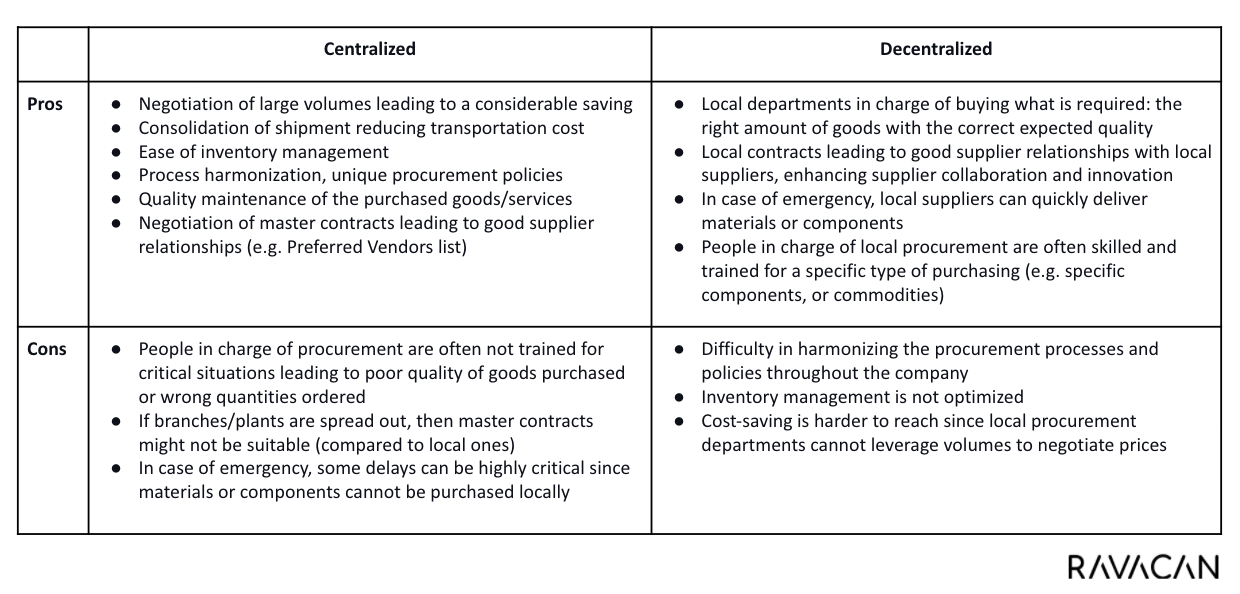The Different Types of Purchasing Organizations

Since procurement is often responsible for up to 70% of companies’ revenue, it has become part of the global organizations’ business strategy over the years. Procurement organizations have evolved towards strategic departments, regardless of the type of business (B2C or B2B) and sector (industry, tertiary), to streamline and organize companies’ buying strategies.
However, building its purchasing strategy and supporting it with the proper organization can be a long and challenging process. Plus, there is no right recipe to achieve this goal. Each company has its own culture, own background, overall strategy, and own global organization.
Companies tend to prefer one purchasing organization to another according to their geographical organization, procurement maturity, business strategy, and other multiple factors.
So, what are the different types of purchasing organizations? How could you determine which kind of organization would fit best to your company?
After defining the purchasing organization concept, let’s discuss the different types of it and their pros and cons, following two axes: centralized VS decentralized and mature VS non-mature purchasing organizations.
What is a Purchasing Organization?
A purchasing organization can be either a distinct company in charge of buying goods and services for multiple companies simultaneously (i.e. Group Purchasing Organization) or a business department within a company in charge of buying goods and services for this same company. This article will focus on the second definition, the goal being to give insights on internal purchasing organizations.
Procurement departments are often seen as a support function, helping business departments perform for the company. It is about time to see procurement departments as strategic partners for the business since such organizations’ impact on companies’ costs and revenues is vast. In the past two to three decades, we have seen purchasing departments rising from single and isolated buyers to complex and organized teams. Procurement departments are often the last strategic department to be developed, and the more mature they are, the more sophisticated they can be.
Then, there are two different ways to analyze internal purchasing organizations:
Centralized VS decentralized: one company would prefer to centralize all the procurement activities within the same team located in the same building; another company would choose to let its branches/plants deal with local procurement activities. However, the same company could have centralized teams in charge of indirect sourcing (i.e. utilities, stationery, IT supplies) and decentralized units responsible for local direct sourcing (i.e. electrical components, raw materials).
Mature VS non-mature: a non-mature purchasing organization would have single workers in charge of procurement activities with few to no specific guidelines or training. A mature one would hire highly skilled buyers responsible for one particular procurement segment (e.g. a single critical commodity).
Let’s dig into these different concepts to understand the roots and challenges behind them.
Centralized VS decentralized purchasing organization
Centralized and decentralized purchasing organizations have different objectives:
Generally located in the company’s headquarters, centralized purchasing organizations save money by leveraging volumes. They buy goods and services for the whole company.
Decentralized purchasing organizations give authority to local departments (e.g. subsidiaries, plants, branches) to buy items as per their requirements.
There is no one right solution, but assessing each type of purchasing organization’s pros and cons could help companies develop their procurement department.

We notice that the biggest cons of decentralized purchasing organizations are that the local branches/plants cannot leverage quantities to negotiate prices with the suppliers, and procurement processes are harder to harmonize. The good news for decentralized purchasing organizations is that solution providers have worked for decades to deliver the best-in-class software to help companies create value through process harmonization, data consolidation, and supplier relationship management. The digitization of procurement processes enables decentralized procurement teams to work together and follow the same policies. For instance, with its accurate demand planning functionality, Ravacan offers companies the power to easily visualize their needs and consolidate components requirements throughout the company and the separate product lines. For instance, if several products need the same components to be manufactured, the company could negotiate one big order instead of multiple single orders leveraging quantities.
Mature VS non-mature purchasing organization
The second type of purchasing organization refers to the maturity of the procurement department within a company. The maturity of a purchasing organization is mainly linked to its people (background, knowledge, training), processes (harmonized, transparent, compliant), supplier relationship management (collaboration, innovation), and tools (process digitization and automation, data collection and analysis, internal and external supply chain collaboration).
Depending on the business, purchasing organizations are more or less mature. For instance, tertiary sector companies do not always appreciate what value a mature procurement department can bring. Stakeholders are often in charge of the relationship with their supplier along with the contract negotiation and order-placing. On the contrary, industries are more likely to develop highly mature procurement departments with organized teams because of their critical needs for direct materials. But even within mature procurement organizations, there are some discrepancies: organizations that have one buyer for several commodities VS organizations that prefer buyers to focus on a single commodity. Depending on the criticality of the items (see the Kraljic matrix), their percentage in the total spend and the level of relationship with the supplier(s) (i.e. single sourcing, dependency, etc.), either one or the other strategy in terms of commodity responsibility would be preferred.
There are different maturity levels, though, and one company cannot go from the less mature to the most one in a few weeks. It takes time to develop a mature, reliable purchasing organization creating value for the company’s business. One of the last steps of being mature for a procurement department is to use efficient tools. Many supply chain software solutions answer the numerous companies’ needs and expectations: data consolidation, supply chain automation, demand scheduling, invoice matching, purchase request & validation digitization, etc. And while we usually consider industry companies as the most mature in terms of procurement processes, it is always surprising to witness that they still use elementary IT tools such as Excel to consolidate their data, waste hours after hours tracking figures, and risk ending up with inaccurate information.
Thanks to analytics features, procurement systems offer sourcing managers real-time, accurate and clear graphs to track their KPIs and adjust their sourcing strategy in consequence.
Develop your Purchasing Organization Strategy to Strengthen your Global Supply Chain
Building a strong, efficient, reliable, and supportive purchasing organization is a challenging process. To avoid wasting time, companies need to assess their global strategy, understand their culture and select the best approach according to their business. Centralized VS decentralized purchasing organization will primarily impact the procurement strategy (cost saving, product quality). Also, the maturity of purchasing organizations will impact their efficiency.
Copyright © 2022 Ravacan | All rights reserved

